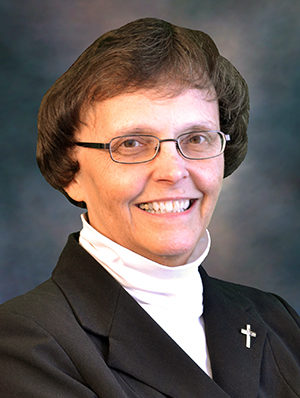
Healing the whole person
Sister Joyce Lehman • President, Sisters of the Precious Blood
Recently we had our annual Jubilee celebration. Although we normally celebrate only silver, golden, 60 and 75 years, we just had to include Sister Dolorosa who celebrated 80 years as a Sister of the Precious Blood. The 103-year-old was unable to join us for the community gala, but we held her close in our thoughts and prayers.
You will notice in this issue that two of this year’s six Jubilarians have been in health care for a significant part of their ministerial lives. We have never been a congregation whose primary ministry was health care, such as building hospitals and establishing health networks. Education in schools and parishes were our primary ministries.
However, as time passed a need arose for Sisters who could serve as nurses, caring first for our own Sisters and then for others in nursing homes. Eventually other Sisters felt called to the healing professions and branched into hospital nursing, home health, medical doctor and hospital chaplaincy.
However, one early foray into health care has left its mark on us as a Congregation. In the late 1800s one of our Sisters was sent to Austria to study with Monsignor Sebastian Kneipp who promoted a daily regimen not unlike what is encouraged today: exercise, adequate sleep and a simple diet. Added to that was a series of water cures which people from many places came to partake of and to study. Sister Margaret Schlachter brought back these water treatments to America and many of the Sisters found relief in them. Shortly after that a doctor who had a sanitarium in northeast Indiana, by Sylvan Lake, was looking for a religious community to take over his failing enterprise. Mother Emma decided that it would be a perfect place to accomplish a three part goal: aid poor, sick children, ailing adults and provide for the Sisters a place to retire in a peaceful, healthy environment.
The sanitarium was located in an area that had multiple mineral springs on the property affording both beauty and an unending supply of pure water for treatments. Our Sisters gave water treatments; provided simple nutritious food, much of it from their own gardens; kept the facility and grounds beautiful for the residents to enjoy all the while continuing the Sisters’ own routine of prayer and adoration.
The Sisters even had a “tea” garden in which were grown many herbs that would be carefully dried and brewed into teas served to the residents. Wormwood, chamomile, mint, fenugreek are only a sampling of the variety. Eventually fewer people came seeking treatments and therapeutic rest, and Kneipp Springs was closed in the mid-70s, just a few years before holistic health became a trend in American society.
It is entirely possible that this early holistic approach to health permeated our Congregation so that today our Sisters continue to affirm the interdependence of body, mind and spirit and with the understanding that the health of each affects the health of the others.
Whether our Sisters ministered in the classroom, the parish, the outreach center, they encountered a whole person: the hungry child who could not concentrate on study; the ailing, elderly parishioner who needed the spiritual support to accept the coming transformation of death; the homeless woman who needed affirmation of her dignity and worth as much as food or a place to stay.
Health, wholeness and holiness have a lot in common. May the coming days and weeks be filled with healthy and holy activity.





